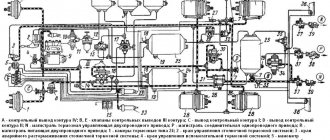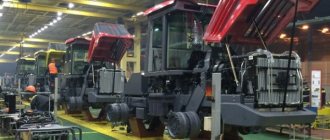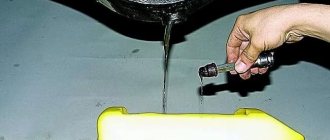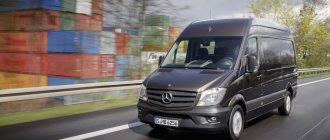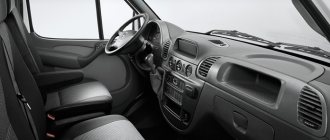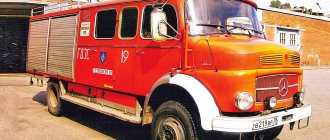The German Mercedes Sprinter is a car from the light-duty truck division. The model is actively used in the commercial field as an assistant for business. The car received various modifications, including: a passenger minibus, a cargo van, a refrigerator and special vehicles. The entire Mercedes-Benz model range.
In addition, on the platform of the latest family, the company presented luxury offices and luxury apartments on wheels, which are equipped with the latest technology. The appearance, coupled with the technical component of the Mercedes-Benz Sprinter, is constantly being improved, which makes this car very popular in the markets of many countries.
The car is equipped with four body options, three wheelbase options and three roof height options, and has twin or single wheels on the rear axle. Load capacity - up to 3,050 kilograms.
Both in European countries and in Russia, the practice of re-equipping and modifying the MB Sprinter on the outside has spread massively. A total of 2 generations of Mercedes Sprinter were produced. Many, despite the new Mercedes Sprinter 515 models released and so on, prefer to use the good old Mercedes Benz Sprinter Classic.
Car history
First generation
The sprinter was introduced in 1995. It was a light-duty truck with a gross vehicle weight of 2,600 to 4,600 kilograms. It was created for multidisciplinary use in various areas - from comfortable passenger transportation to transportation of building materials in enterprises and household plots.
In the list of similar cars, the Mercedes Benz Sprinter stands out for its versatility and efficiency. The platform for building the Sprinter was the base of the T1 light-duty vehicle, which has been very popular since the early 1980s.
Mercedes-Benz Sprinter first generation
The car managed to not only maintain the high bar of the previous car, but even become more successful. The debut generation was produced in 9 standard trim levels, which included diesel, gasoline engines, and gas equipment.
The development of the machine began back in 1992. Tests of pre-production copies took place over three years at testing grounds in three countries - Germany, France and Spain.
First generation Mercedes-Benz Sprinter van
The company put all its efforts and all its accumulated experience in light-duty commercial vehicles into production of the Sprinter. The first generation of the small truck was equipped with power units ranging from 80 to 160 horsepower, and the load capacity ranged from 750 kg to 3,500 kg on the 6th series.
The Germans made a significant step forward - they moved away from the dependent suspension design, fundamentally improved handling and reduced the turning radius by 15 percent.
Photo of the first generation Mercedes-Benz Sprinter van
The leaf spring suspension was completely redesigned, using a transverse spring at the front and longitudinal springs with variable thickness at the rear. All this made it possible to increase the suspension life by one and a half times.
Thanks to a bold experiment in introducing a carbon fiber spring into the front suspension, it was possible to fully replace metal elements when designing the 2nd generation Sprinter.
During the development of the steering mechanism, the engineering staff decided to completely abandon the steering gear. Instead, they installed a rack and the obligatory hydraulic power steering wheel.
Thanks to the fastening through silent blocks to the beam, it was possible to reduce noise and increase the already long service life of the vehicle. If we talk about the gearbox, then rubber-metal couplings were no longer used in it.
First generation Mercedes-Benz Sprinter minibus
We decided to use a dual-mass flywheel with an integrated damper. Long-wheelbase vehicles received a design with a pair of outboard bearings. After that, the driveshaft ran for an average of 500,000 kilometers.
The suspension installed in front was created from scratch, because instead of kingpins, shock absorber struts with ball joints were installed, and the upper part had rubber-metal ball joints. The rear suspension was the same as on the T1, only it was modernized.
Photo of the first generation Mercedes-Benz Sprinter van
Many elements have been time-tested and have proven themselves positively, so they were transferred to the new product with minimal modifications. Changes also affected the outer bearings of axle shafts on axles with single wheels - if previously they were single-row ball bearings, now they are double-row conical.
Due to the fact that the car was planned to be used in various operating conditions, initially the technical equipment set had a locking differential on the rear axle, which was equipped with the option of being activated in automatic mode.
Photo of the first generation Mercedes-Benz Sprinter minibus
A little later, models with an all-wheel drive system saw the light of day. These were cars that had a front axle, and models that were equipped with a permanent all-wheel drive system with a reduction gear in the transfer case.
The first generation managed to take home the Van of the Year award, which was awarded to it in its first year of production.
Such a successful start was followed by an equally successful continuation, as eloquently evidenced by the number of copies produced (about 500,000 units), which almost doubled the total circulation of T1s produced. Initially, the car was sold only in European countries.
Different Sprinter models were equipped with three power units of 2.3 and 2.9 liters with turbocharging, which operated on diesel fuel. In addition, a petrol variation of the 2.3-liter engine was provided. All power units are synchronized with 5-speed gearboxes - automatic and manual.
Front view of Mercedes-Benz Sprinter first generation
In 2000, the car underwent modernization. In particular, the previous diesel engines were discontinued and replaced by more environmentally friendly and economical 2.1-liter and 2.7-liter engines. The petrol variation has been upgraded along with the transmission.
Now the power unit had the Common Rail direct injection function. More cars of this release received a single CDI index. In addition, specialists have introduced an electronic motion stabilization system into the equipment of their own cars.
Mercedes-Benz Sprinter 1995
The following year, 2001, the car went on sale in the markets of North America and Japan. In the United States of America, the minibus/van was produced under the name Freightliner Sprinter, and in Japan - the Mercedes-Benz Transporter T1N.
Another 2 years later (in 2003), the German company decided to enter into an agreement with the American company Dodge on the joint production of this car, which has since been sold on the North American market under the name Dodge Sprinter.
Photo of a 1997 Mercedes-Benz Sprinter
In total, over the 11 years of production of the first generation, 1,300,000 Sprinter vehicles were sold. Also in 2003, the Mercedes-Benz Sprinter underwent another improvement, which affected most of the model's appearance.
In addition, as a result of the introduction of fresh high-tech power units and high-quality electronics into the lineup, the minibus has become more dynamic and “smarter,” having acquired real intelligence from the engineers.
Second generation
The second family of famous cars was introduced in Europe in 2006. Fans saw the car in six body styles - a minibus, a van, flatbed versions with two and four doors. In addition, a distinctive feature of the second family was the presence of a choice of three types of wheel bases.
The model with the shortest platform received 3,000 millimeters, with 5,070 millimeters in length and 1,933 millimeters in width. The turning radius was 11.2 meters. The longest wheelbase of the Sprinter is 4,025 millimeters, and the average is 3,550 millimeters.
Mercedes-Benz Sprinter second generation
Changes also affected the exterior of the body. For example, a chrome-plated steel radiator grille, massive bumpers, neatly shaped headlights, “muscular type” wheel arches, and large air intakes appeared, which allowed the car to look more brutal and solid.
As mentioned earlier, the van received, in addition to everything, a stability control system, a hydraulic power steering wheel and electric windows. For many car enthusiasts, this is the well-known Mercedes Sprinter Classic.
Photo of the second generation Mercedes-Benz Sprinter
The most powerful was the 3.5-liter gasoline engine, which produced 285 horsepower. It is synchronized with a 5-speed automatic transmission and also has rear-wheel drive.
In urban areas, such a powerful engine requires about 17.3 liters per 100 kilometers, and when driving on the highway, consumption drops to 10.3 liters per hundred.
But the most “representative” power unit from the diesel line is a three-liter 190-horsepower engine, which also has a rear-wheel drive system, but is paired with a 6-speed manual gearbox.
MERCEDES-BENZ SPRINTER 1995-1999
Welcome, Guest! (Login | )
Cart: empty
TOTAL AMOUNT (including discount) empty
Go to cart
Spare parts for Mercedes-Benz Sprinter, Vito, Viano and Volkswagen LT, Crafter
- 8-(925) 5-171-171
- 8-(495) 971-28-50
- Shokalsky passage, Vlad. 50, 3rd floor
- All contacts
- Spare parts
- About Us
- Brands
- Machine overview
- Question answer
Open navigation bar
Sections of the site
- Spare parts
- About Us
- Brands
- Machine overview
- Question answer
Information
- CAR REVIEW
- MERCEDES SPRINTER Mercedes-Benz Sprinter 1995-1999
- Mercedes Sprinter 906 body (2006-2015 onwards) MERCEDES BENZ SPRINTER 209CDI Overall dimensions
- dimensions
- dimensions
- dimensions
- dimensions
- dimensions
- dimensions
- dimensions
- dimensions
- dimensions
- dimensions
- dimensions
- dimensions
- dimensions
- dimensions
- dimensions
- dimensions
- dimensions
- dimensions
- dimensions
News 12/21/2019
On the eve of the New Year, we are giving out gifts to all customers of our store - from December 23 to 31...
15.05.2018
To improve the search for parts, we are modernizing the menu of spare parts categories. Now, apart from the breakdown...
10.04.2017
New items have appeared in our warehouse - rear door hinges for Mercedes-Benz...
Home » MERCEDES SPRINTER » Mercedes-Benz Sprinter 1995-1999
- Mercedes-Benz Sprinter 1995-1999
- Mercedes Sprinter 906 body (2006-2015 onwards) MERCEDES BENZ SPRINTER 209CDI Overall dimensions
- dimensions
- dimensions
- dimensions
- dimensions
- dimensions
- dimensions
- dimensions
- dimensions
- dimensions
- dimensions
- dimensions
- dimensions
- dimensions
- dimensions
- dimensions
- dimensions
- dimensions
- dimensions
- dimensions
In 1995, the premiere of a family of light trucks and minibuses jointly developed by Volkswagen Nutzfahzeuge (commercial vehicle division) and Mercedes-Benz AG took place - the Mercedes-Benz plant in Düsseldorf began producing a new minibus called the Mercedes Sprinter.
Light-duty trucks with a gross weight of 2.6 to 4.6 tons were intended for multi-purpose use in various fields of activity - from transporting construction materials to comfortable transportation of small groups of passengers. Three wheelbase options were created - 3000, 3550 and 4025 mm.- as well as two roof height options.
In addition, modifications were produced with cargo platforms with both single and twin cabins. A special version of the car was also produced: a two-door modification (one door only for the driver) Sprinter XXL, with an overall length of 7200 mm and a cabin width of 1930 mm, could comfortably transport 15-17 people.
The appearance of the car has changed radically - manufacturers abandoned the old half-hood design and replaced it with a more modern one, with a sloping hood of a regular shape. Improved dynamic and performance characteristics of the vehicle, excellent handling, reliability and a high level of technical equipment for its time made the Sprinter popular not only in Europe, where the vehicle was awarded the title of “Best Commercial Truck of 1996-1997,” but also in America. For the North American market, Mercedes' local production facilities began producing Sprinter modifications under the Dodge and Freightlinter brands.
The interiors of minibuses and truck cabins are practical and comfortable. The driver's seat is adjustable in four directions and can be easily adjusted to suit any height. Excellent ergonomics of the driver's workplace - all controls are located exactly where they should be. Additional convenience for passengers is provided by such pleasant little things as, for example, cup holders on the hinged lid or heated seats.
The volume of the cargo compartment/passenger compartment varies from 7 cubic meters. (“short” - 3000 mm - wheelbase and standard roof) up to 13.4 cubic meters. (“long” base in combination with a high roof). The latter option can easily accommodate four Euro pallets. Convenience of loading and unloading operations is ensured by sliding side and rear full-hinged doors (with an opening angle of 270 degrees).Modifications with an onboard platform or dump trucks have a load capacity from 750 to 3715 kg.
One of the undoubted advantages of the new Sprinter is its fairly powerful, but at the same time economical, and easy to maintain and repair engines.
The line of Mercedes Sprinter power units initially featured a 2.3-liter gasoline and three diesel engines: a 2.3-liter four-cylinder in-line. 79 hp and turbocharged five-cylinder 2.9 liters. with a power of 102 and 122 hp. In 2000, the diesel range was replaced by three 2,148 cc turbocharged four-cylinder engines. with a power of 82, 109 and 129 hp. and a five-cylinder forced engine with a volume of 2.7 liters. 156 hp
A big evolutionary step in the development of light-duty vehicles was the use of power-assisted rack-and-pinion steering. This made the handling of minibuses at the level of a passenger car. A new layout with an independent front suspension with a transversely mounted spring and a rear solid axle with longitudinally mounted parabolic springs provides the cars with enviable durability and reliability.
Particular attention is paid to active vehicle safety.
The safety of passengers and the safety of cargo is ensured by brakes that are effective even during sudden braking of a fully loaded vehicle - for the first time in this class of vehicles, the ABS/ABD system was standardly used. In addition, an optional ASR traction control system could be installed to assist the standard one. Passive safety for passengers is provided by three-point seat belts with installed pretensioners. For transported cargo, passive safety is implemented by durable rigging straps with reinforced fastening holes in the strength elements of the vehicle body structure, as well as special rigging rails additionally installed on the sides and floor, allowing the cargo to be securely secured in place. © MBTruck, 2004 - 2022
- Spare parts
- |
- About Us
- |
- Brands
- |
- Machine overview
- |
- Question answer
- Moscow, Shokalsky Prospect, 50
- +7(495)-5-171-171, (495)-971-28-50
- [email protected]
- Skype: mbtruck.moscow
- All contacts
- Favorites (0)
- Compare (0)
- Viewed products (0)
Up
Restyling 2013
Exterior
In the fall (September) 2013, the German company made a restyling for one of the most popular utility vehicles, which this time affected the appearance of the car and its safety systems.
The most noticeable innovations include the presence of an updated design of the bow body, which includes a new radiator grille and headlights, the style of which is reminiscent of passenger cars from a German company. On top of that, the vehicle received a unique hood and an upgraded front lighting system.
Updated Mercedes-Benz Sprinter
It was possible to achieve increased resistance to side winds thanks to the modified ground clearance, which became 3 centimeters less. To make the visual perception of the car special, a design team led by Laurent Boulay was involved in the work, who did everything possible to endow the Mercedes with features atypical for this class.
The body shape has undergone changes and has become more streamlined than its predecessor. In addition, the model has a large U-shaped radiator grille, where there are two wide chrome “ribs” dividing it horizontally. The headlights have become larger and have a diamond-shaped appearance with rounded corners.
Minibus Mercedes-Benz Sprinter 2013
The hood is now more prominent, convex, and there are two ventilation holes on the top side. The front bumper has changed structurally - it now has a wide air intake in the center in the form of an inverted trapezoid and teardrop-shaped holes on the sides in which foglights are installed.
The design of the side and rear doors has also undergone changes - they have increased in size and received streamlined shapes. The glass area has become larger due to larger side windows and U-shaped windows on the rear doors.
Side view of Mercedes-Benz Sprinter
The side of the body is endowed with a stamping that is fashionable today, which smoothly expands from the side doors in front, passes through the rear body and stops at the doors installed at the rear.
Restyling introduced wide plastic protective elements in the form of a body kit along the entire perimeter of the body. The appearance of the rear lights has improved; they are now larger, but remain in a vertical position.
Interior
The interior of the modernized car was also significantly transformed. The driver's workplace now looks completely different. We installed a new instrument panel under a large hemispherical visor. The “tidy” has a massive tachometer and speedometer, between which there is a neat small “window” of the on-board computer.
The steering wheel has a medium size and four spokes. A massive rectangular console was installed on the central part, into which a transmission shift lever was placed on the driver’s side. The seats are adjustable longitudinally and vertically. Top configurations have the function of adjusting the lumbar support.
Mercedes-Benz Sprinter interior
The upper part of the console has a compartment for various small things, and below it is a block of a multimedia system with a wide screen. The bottom of the console is intended for the climate system settings unit and service buttons.
The upper right part of the dashboard is occupied by a deep niche where you can put various papers. Below it is a spacious glove compartment. The engineering team has improved the design of the driver and passenger seats.
Mercedes-Benz Sprinter interior
All seats have active head restraints and seat belts. Passengers can get inside the cabin using the side or middle sliding door. The luggage compartment has a modest volume of 140 liters with a nine-seat interior layout.
The interior space of the car has become significantly better. The interior is now more elegant and stylish thanks to an abundance of chrome elements, and the seats have excellent, practical high-quality upholstery.
Photo of Mercedes-Benz Sprinter interior
The steering column has a “chubby” shape that many drivers like. Therefore, the ergonomic component of the steering column has increased significantly. You can't help but notice the more modern audio and navigation systems.
Specifications
Engine
If we talk about technical equipment, and more specifically, engines, they remain the same. Although the power units remained the same volume, they underwent minor modifications that allowed the vehicles to meet stringent Euro-6 environmental standards. There are a pair of 2.1-liter turbocharged diesel engines producing 109 and 150 horsepower.
Engine Mercedes-Benz Sprinter City
The gasoline version also received 2 versions - for 56 and 258 “horses”. A large percentage of toxic gases are neutralized by injecting urea into the catalyst. This innovation was named BlueEFFICIENCY and gave the car a chance to be a contender for the title of the first car that fully complies with the environmental standards of the “new era”.
Engine Mercedes-Benz Sprinter Worker
The consumption of the power unit as standard is as follows: in the city 15.8 - 16.3 liters per 100 km, on the highway 10.7-11.2 liters per 100 kilometers, and the combined consumption is 13.3-13.8 liters per every 100 kilometers.
Transmission
Diesel engines are synchronized with a 6-speed EcoGear manual transmission, while gasoline engines come with a 6-speed automatic gearbox. After some time, they began to install a 7-speed automatic transmission 7g-Tronic Plus. The car has rear-wheel drive/all-wheel drive.
Passenger modifications of cars and vans were included in the restyling, and this eloquently indicates that most Mercedes-Benz Sprinter cars will continue to be in demand and popular among buyers in many countries around the world.
It would not be superfluous to remind you that the updated 2013 Sprinter will be produced at the Gorky Automobile Plant. Hence the reduction in their price by 20% from the cost of those produced in European countries.
Mercedes-Benz Sprinter Classic
In the Mercedes model range there are different cars from a tiny smart to a long-haul tractor. Therefore, today we will look at a sprinter, and not the simplest one, but with the classic prefix, that is, made in Russia.
Mercedes-benz sprinter classic appeared on our market after a scandal. In 2013, the sollers group that produces the Ford Transit pushed through huge anti-dumping duties and it was the Germans who suffered the most from the new laws.
For Mercedes, customs duties soared to forty percent of the cost of a new car. As a result, the German brand had to start producing trucks in Russia; the sprinter from the year before last was chosen as the model, and the Gorky Automobile Plant was chosen as the assembly site. Moreover, Mercedes immediately set its sights not on screwdriver assembly, but on full-cycle production, that is, with welding and painting. To localize production, Daimer attracted 11 domestic suppliers; even the front panel in the cockpit and the engine are of Russian origin. It was assembled by the Yaroslavl Motor Plant.
Why did I do it because a few months ago the sprinter classic quietly left Russia. The reasons why this happened are given very different, but the fact remains. You can’t buy a new car like this anymore, but is it worth looking for it on the used car market? After all, the same sprinters, but of German origin, seem to be quite in demand on the secondary market.
A used Mercedes benz sprinter classic can no longer be found new; used versions start at 700,800 thousand rubles, while an all-metal van or minibus prices are almost the same.
The exception is the tourist versions, which are more expensive. As for the German oldies, you can grab them for two hundred to three hundred thousand, but you will have to invest almost the same amount, while a good version costs a million to two million, and it would seem that despite the not very low price tag, these options still find their owners.
By the way, in terms of corrosion resistance, the Russian is even better than the German. Especially for us, Mercedes worked on the quality of the paintwork, making it more durable. The Germans did not skimp on installing a painting complex in Nizhny Novgorod for 50 million euros, but the build quality can be disappointing. The doors do not slam shut as easily and clearly as on the Germans; as for the durability of the body, on the capital's roads it can rot to the point of holes in 7-8 years.
First of all, this concerns minibuses, which are aging the fastest. The reason is temperature changes due to constant opening of the door; in addition, there is always high humidity in the passenger compartments.
And of course, the reagents, their destructive effect, is especially visible on cars that worked in Moscow outside its borders, even a ten-year-old minibus can look very decent; as for the interior, the first thing to do is count the number of seats.
It must coincide with the data indicated in the documents, and especially check which category Mercedes belongs to. Buses are often made from vans, but the owners also forget to issue permits for such alterations.
A known problem with all buses of this format is sliding doors. The Sprinter has a fairly successful design, but it will still need repairs over time; an alternative option, which is practiced by many carriers, is to plug the sliding door and organize entry and exit through the right hinged door. But to do this, of course, you will have to remove the seat to the right of the driver, and at the same time arrange additional handrails.
Owners most often complained about a poorly glued windshield, which allowed water to leak through the joint. In addition, the assembly line did not learn how to properly install and adjust the sliding door. As a result, the owners of sprinters demanded this from dealers. The bodies had rust and cracks in the sealant along the drainage groove.
On cars assembled in Nizhny Novgorod, the parking brake cables froze, and the problem took two years to solve. Also, the webasto pre-heater sometimes threw up errors. Play in the ball joints haunted the classic throughout his life, and the Russian Germans also experienced accelerated wear of the anti-roll bar bushings, as well as play in the steering rack; they were replaced under warranty.
A little less often, rear axle seals leaked due to a pinched breather tube. There was a knocking sound from the front supports and the front shock absorbers themselves, and sometimes the front axle spring even burst.
From a technical point of view, the classic is a body from a second-generation sprinter, but with an engine from a third-generation sprinter. The turbodiesel is reminiscent of the Yaroslavl assembly. There is absolutely no need to be afraid of this, although in addition to assembly operations, YaMZ also performed mechanical processing of key parts, but in 2017, the Yaroslavl Motor Plant received the so-called quality premium from Daimler. This means that the plant produces high-quality products. The work on assembling motors and machining parts fully complies with the German standards of efficiency and quality of the company.
Engine
But the fact that the engine can go to capital without waiting for 100 thousand kilometers is not the fault of the Yaroslavl Motor Plant. Daimler engineers simply simplified the design of the crankshaft, and technologists suggested using cheaper steel. As a result, something like this happens.
With age, the main bearings of the cylinder block become elliptical, and then a chain reaction starts. The main bearing caps become deformed and begin to wobble over time, causing the liners to rotate, finally breaking the seats, and if the driver does not turn off the engine in time, the crankshaft will crack or break.
As a rule, this happens between the 2 main and 2 crankpins, and then the driver will see the consequences with his own eyes. When a connecting rod breaks through a cylinder block, and yet a new short block costs an exorbitant 600 thousand rubles.
But eliminating the consequences of turning the connecting rods is not a problem; today they charge less than ten thousand rubles for work.
True, you will have to pay separately for the removal of the unit and, of course, for spare parts in general, our mechanics are very, very familiar with these engines and here’s why.
In 1983, a 2-liter naturally aspirated diesel engine appeared on the Mercedes-benz 190 sedan. Over time, it acquired turbocharging and other innovations, when it was brought up to euro 4 standards, the index changed to on 646. So, despite the increased power, the basic dimensions of cylinder blocks and crankshafts have not changed, and the crankshaft, as we have already said, has become even less durable, so that buyers of all second-generation 4-cylinder sprinters, both with and without the classic prefix, have a chance of getting a lot of problems out of the blue. In this regard, 5-cylinder options are more reliable.
They have a lower load on the crankshaft bearings due to a larger number of supports, but with such engines you can only buy German cars; they stopped being produced back in 2006.
On the other hand, many carriers have fours that travel 300-500 thousand kilometers without any problems at all. There are examples of million-plus engines. So the question seems to be about driving modes and timing of oil changes when the lubricant meets the Mercedes tolerance and changes in time, and the cars drive long distances with the engine there will be no problems
It is recommended to unscrew glow plugs, as well as injectors, at least once every 50 thousand kilometers, and then put them on thermal paste; if this is not done, they may sour and then the plugs will have to be drilled out
Transmission
Unlike the engine, the gearbox is the standard of reliability. Unless the cable drive of the joystick may fail due to frequent switching. In this scenario, there are all sorts of things, either the cables (and there are two of them here) fray, or the fork itself breaks.
In some cases, the mechanism located directly on the joystick breaks down. The timing of when such repairs will be needed is difficult to predict; for example, for minibuses it is 50-70 thousand kilometers, and for cars operating between cities it is about 150 thousand. The same statistics with the clutch of minibus taxis - the driven clutch disk lasts less than one hundred thousand kilometers, and for some record holders only 50 thousand, but there are examples when clutches were changed after driving 150 thousand kilometers and even 200 thousand
In general, everything greatly depends on the operating conditions and, of course, the driving style of the particular driver, but there are no questions at all regarding the cardan transmission and rear axle. This 2 sprinter is especially good because its successor turned out to be very problematic precisely in terms of transmission. There, the outboard bearings last 30 thousand kilometers, and the crosspieces last 70 thousand, but in the Sprinter classic all these parts are considered almost eternal.
Suspension
From the side, the front suspension from the printer is very similar to a passenger car with stamped arms, shock absorber struts and a rack and pinion steering mechanism, but there is a very non-standard element - a powerful transverse spring, according to the manufacturer, this scheme was chosen for layout reasons.
Firstly, it allows you to maintain good load capacity, but at the same time remove the wheel arches from under your feet, that is, make the floor in the cabin flat, and especially for our roads, the Germans strengthened the shock absorbers and anti-roll bars. Moreover, the smoothness of the ride was not affected, and the greater the load, the more comfortable the car was.
The rear suspension is purely leaf spring; however, in advertisements you can find options with air springs; this is the result of non-factory tuning. In Russia, they developed a kit that literally takes two to three hours to install in standard places; such modification costs about 35,000 rubles, including parts and labor. As for the timing of the chassis upgrade, the front shock absorbers and wheel bearings are the first to be delivered; this usually happens after one hundred thousand kilometers. By the way, the ball joints can wear out and the entire three hundred thousand kilometers can be replaced by yourself, and if you get a mandrel, that is, the sales blocks can be updated on your own.
Brakes
The second generation sprinter, including the classic, is a car that does not necessarily require a service trip, especially to replace brake pads, which costs 15-20 thousand per minibus.
A common opinion is that the prices for spare parts for Mercedes are supposedly high; in fact, for old sprinters, including classic, branded components actually cost only a little less than on the newest ones.
Conclusion
The second generation Mercedes-Benz Sprinter is a development of a 1995 model, that is, the truck was made using technologies from the early 90s, and then, as you know, they knew how to make a car. Therefore, the commercial Mercedes turned out to be quite strong, durable and, in addition, suitable for independent maintenance. As for the classic version, the Russian assembly turned out to be by no means a reference, although it did not seem to bring any serious problems either.
The overall result is that there are no serious problems with the body if vans and buses operate far from the capitals, but with engines and gearboxes if the car goes long distance.
In general, the second generation Mercedes-Benz Sprinter proved to be a very reliable and durable car. Moreover, the costs of its operation, despite its solid pedigree, are relatively small, and the resale market price is still relatively high.
Safety
The German company paid maximum attention to the issue of safety in its modernized version of the Mercedes-Benz Sprinter. The engineering staff did their best and equipped the model with a large number of relevant systems and electronic assistants.
For example, the Crosswind Assist function, which allows you to provide auxiliary protection against side winds by automatically activating the braking devices. Also, as a separate option, the Highbeam Assist system (high beam adaptation), Collison Prevention Assist (prevents collisions) and Blind Spot Assist (lane change assistant) are installed.
2022 Mercedes-Benz Sprinter
The Sprinter is now equipped with another protective function, which automatically causes the car's brake lights to flicker during emergency braking at a speed limit of 50 km/h. If emergency braking occurs at a speed limit of 70 km/h, the system automatically turns on the hazard warning lights.
As mentioned above, considerable emphasis was placed on active safety, since working at full load and in extreme conditions requires extreme performance. Installation of front and side airbags is provided.
Mercedes-Benz Sprinter rear view
This light-duty vehicle has a whole range of systems responsible for ensuring the proper level of safety for the life and health of passengers. There are disc brakes on all wheels, which work perfectly even during sharp braking of a fully loaded vehicle.
Equipment includes ABS/ABD. As a separate option, the ASR traction control system is installed along with ABS, which helps prevent wheel slipping and guarantees confident traction on wet and slippery road surfaces.
Photo of the updated Mercedes-Benz Sprinter
For use in difficult conditions, there are versions that disable the all-wheel drive system. They did not forget to provide a Duo-Servo hydraulic parking brake for the rear wheels, which operates independently of the service brake.
The new product has good deformation characteristics - thanks to the reinforced design of the nose of the frame, it takes on most of the impact force during a frontal collision.
To better secure the car, you can install airbags in the Mercedes-Benz Sprinter for the driver and the passenger sitting next to it, and three-point seat belts on all seats.
Crash test
The new model has passed three types of frontal crash tests. The first is mandatory, according to ECE R12 standards. It is necessary to accelerate the car to a speed of 48.3 kilometers per hour and hit a hard barrier.
In addition, the Germans tested their minibus according to ECe R94 standards - at a speed of 56 km/h there is a collision with a deformable barrier with a 40% overlap. The company also simulated an accident in the city - a speed of 15 km/h, a rigid barrier without overlap.
According to the developers, they managed to improve the passive safety of the vehicle. During an impact, the Sprinter's steering column folds in three areas at once. Airbags fire not only from the front, but also from the side panels (where they can be built in upon request).
The front suspension subframe is capable of “breaking out” of specially designed fasteners and bending. The front ends of the side members begin to compress like an accordion, which allows them to absorb the force of the collision.
Interestingly, Mercedes specialists have specially developed replaceable side member elements that are mounted and welded to replace the flattened ones. According to the crash test, it became clear that during an impact they behave no worse than those installed by default.
1995: Sprinter
Author: NatanNatanych
The MB Sprinter of the Daimler-Benz concern is a representative of the family of light-duty trucks and minibuses.
| Mercedes-Benz Sprinter |
The debut of the first generation of MB Srinter models took place in 1995. Light-duty vans and minibuses, with a gross vehicle weight of 2.6 to 4.6 tons, are ideal for commercial passenger and freight transport in terms of the scope of tasks that the vehicle can perform. The versatility is due to the fact that representatives of this family of trucks equally well provide comfort during the transportation of passengers, and the reliability of transporting production cargo or building materials, and the vehicle's cross-country ability on rural roads when used on farms. The variety of functions that a light-duty vehicle can perform is successfully combined with efficiency, which distinguishes the Sprinter family from other brands of minivans and vans. “MB Sprinter” is produced in various modifications, taking into account the specifics of the application. Cargo van, minibus, chassis, flatbed or tipper – to solve any transport problem there is a Sprinter produced under the Mercedes brand. Everything has been thought out for efficient work and convenient movement:
- two variations of roof heights - standard and high;
- the possibility of supplying a car with a double cabin, providing space for the driver and nearby neighbors in the cabin;
- wheelbase variability (3000 mm, 3550 mm, 4025 mm), allowing you to choose the optimal body length.
| Mercedes-Benz Sprinter |
The ergonomic design of the light-duty vehicle from the list of “MB Sprinter” models combines a half-hood layout, a body with a monocoque body on a powerful subframe, an engine located longitudinally in the front and rear-wheel drive.
The classic design principle and excellent road performance led the MB Sprinter to a well-deserved place on the podium - along with the Vito models, the cars held the title of “minibus of the year” for two years. The convenience and comfort of the minibus interior allows it to be used in the luxury service category, for example, at wedding ceremonies, outdoor banquets and other special events.
In addition to the comfortable arrangement of the interior space, the Sprinter light-duty vans are distinguished by their high cargo compartment capacity. The useful volume of a van with a short wheelbase and a standard roof is at least seven cubic meters, and in a model with a long wheelbase and a high roof it can reach 13.4 cubic meters. Options with an onboard platform or a dump truck body with a long wheelbase are quite capable of transporting boards four meters long or four Euro pallets. This, despite the relatively compact dimensions of the truck, is possible due to the fact that the vehicle is equipped with a side sliding door and rear doors, the doors of which can be fixed in several positions. Limiters allow the rear doors to be opened at an angle of 90 degrees, 180 degrees or fully open to 270 degrees so as not to interfere with the operation of the loader. The vehicle's carrying capacity in these two modifications is more than 750 kg with a total weight of 2.59 tons, and in six-ton flatbed or dump trucks it is within 3,715 kg. The MB Sprinter with its two-row cab type can be used by a group of seven people, for example, it is a very suitable way of transporting a crew working on a rotational basis. In vans with partial glazing of the combined type or minibus, nine people can comfortably accommodate, in addition to the driver (depending on the optional layout of two- or three-seat rows of seats).
History of the MB Sprinter
| Mercedes-Benz Sprinter |
The first generation of MB Sprinter models consisted of nine basic modifications. The first three are not very powerful cars of the 208D, 308D and 408D models. Their level can be assessed by understanding the digital and alphabetic symbols in the markings. The first digit (in this case “2”) means the total weight of the car in tons, rounded to the nearest whole number, the second and third - the engine power in horsepower divided by ten, also rounded, “D” - diesel. The modifications were equipped with a 2.3-liter four-cylinder diesel engine with a capacity of eighty horsepower. By limiting the production of vans with these parameters, the company, of course, would greatly narrow the scope of potential commercial vehicles, and for larger-scale transportation, MB Sprinter light-duty vans were offered in as models 212D, 312D and 412D. As can be seen from the markings, they were equipped with a more powerful (from 102 to 120 hp) diesel engine (five cylinders, 2.9 liters), and the total weight, according to technical documentation, was three and a half tons.
| Mercedes-Benz Sprinter |
In addition to diesel units, the first-generation MB Sprinter lineup was replenished with three cars equipped with 2.3-liter sixteen-valve gasoline engines - 214, 314, 414. They led the Sprinter line. Already from the numbers in the labeling it is clear that these are more powerful (143 horsepower), compared to their diesel relatives, trucks capable of transporting cargo up to 4.5 tons. And to top it off, a small number of Sprinter light-duty vehicles are equipped with a dual-fuel engine (in the labeling they are designated by the abbreviation “NGT”). Gas tanks that consume gasoline and methane are equipped with a 2.3-liter engine with a power of 125 horsepower.
Capabilities of MB Sprinter vehicles
Starting with a modest dozen models, thanks to the combination of various variations of the body, cab, wheelbase and the possible presence of various additional options, today the concern has mastered the production of 160 modifications of vans, platforms, minibuses and minivans of the Sprinter family.
| Mercedes-Benz Sprinter |
The van body, which can be assembled in fifty layout options, is one of the most popular models of the family of light-duty vehicles, bearing the prestigious three-pointed star of the Mercedes brand on the radiator grille. The following are in great demand:
- all-metal closed vans with standard and high roofs, with a volume of internal body space from 7.0 to 13.4 meters per cube;
- platforms, both with short and long cabs, equipped with PTO (power take-off boxes), which determine the level of power transmitted to the attachments;
- combi-vans with partially glazed bodies, designed for simultaneous transportation of passengers and cargo;
- minibuses.
The possibility and relative ease of retrofitting the basic cabin with various items that increase comfort (comfortable passenger seats, electric sliding doors, installation of an air conditioning or climate control system, double glazing, installation of a side sliding door on the left side, installation of a step under the rear doors) leads to the fact that, having been in the hands of specialists at tuning centers, Sprinter mini-buses become a very popular, prestigious, premium means of transportation.
| Mercedes-Benz Sprinter |
Models of the MB Sprinter family of light-duty vehicles are equally well suited for high-speed driving on the highway, for driving along busy city highways, and for masterful maneuvers in tight alleys and industrial zones. Good handling and maneuverability of the car is largely due to the power steering and rack and pinion steering mechanism. At the front of the trucks there is an elastic independent suspension (spring-lever). The rear axle is continuous, on parabolic springs. It is the rear continuous axle that allows the car to behave obediently on slippery winter roads, on which, even with a good, even surface, the tires become sensitive to the slightest changes in track. An option for assembling all-wheel drive vehicles is possible: either a transmission with permanent all-wheel drive, or with a differential drive (with the mode of connecting the front axle and using a reduction gear). One of the additional measures is to equip drive axles with different gearbox ratios with locking mechanisms. The latest generation of MB Sprinter models is equipped with four new diesel engines, as well as a gasoline engine with an improved design. Cars have power from 82 horsepower (60 kW) to 156 horsepower (115 kW), while the engines are economical. The maximum power developed by light-duty Sprinter trucks falls within the range of 1400-1600 rpm – 2400-2600 rpm. An optional mechanical automatic transmission with a function of switching to manual mode is installed, which allows you to use the maximum torque with the greatest impact, providing smooth, fast acceleration without jolts. Fuel savings when installing new, improved engine modifications generally range from 3 to 5% when compared with previous engine options. In addition, it is possible to install a system responsible for automatically starting and stopping the engine. This will also reduce fuel consumption, since the system turns off the engine three seconds after the car has stopped, and even when crossing a controlled intersection with a red traffic light, the system begins to “save energy”, saving another 2 to 8 percent of fuel. Increasing the vehicle's mileage results in a longer service life for the engine. The battery fuel system with direct fuel injection (common rail type system) is considered a technological breakthrough, significantly reduces the emission of harmful combustion byproducts and reduces the noise level of the running engine. If a car owner changes the oil not according to time intervals, but depending on the load during operation, he will certainly be helped by the Assyst service system, which monitors the actual need and regulates oil change intervals.
Security "MB Sprinter"
| Mercedes-Benz Sprinter Luxury |
One of the main theses that guides the developers of the world brand “Mercedes-Benz” when creating models can be stated: “Safety above all.” The developers of the equipment for the Sprinter range of vehicles attach great importance to the active safety of the vehicle. If work takes place under maximum load and in an environment close to extreme, the car must have a serious system that ensures the safety of life and health of everyone in the car. In order to prevent accidents and other possible incidents on the road, disc brakes are installed on all wheels, operating effectively even when emergency braking is performed by a fully loaded vehicle. Basic equipment includes an anti-lock brake system - ABS - and a wheel slip braking system (ABD) as standard. When assembling to order, in addition to the mandatory ABS, it is possible to install an ASR system (an anti-slip device for the drive wheels), which allows the driver to feel confident even when making sharp bends and turns on slippery roads. Modifications produced with switchable all-wheel drive provide the opportunity to operate the vehicle in the most difficult road conditions. The parking brake is represented by a hydraulic Duo-Servo system on the rear wheels, operating independently of the service brake.
| Mercedes-Benz Sprinter |
The reinforced front frame frame allows the load to be redistributed in a frontal collision, which provides an additional level of safety for the vehicle interior and its occupants. In the event of a rear impact, the direction of deformation is also precisely calculated - the driver, passengers and cargo are reliably protected by the rear cross member. Additional equipment with airbags and three-point belts with tensioners installed in the driver's seat and front passenger seat also helps to increase safety. Three-point seat belts are also provided for all passenger seats located in the cabin. The ESP stabilization system was created by Mercedes engineers back in 1995 and since 1997 the electronics have been installed on class A cars. Then, after significant modifications, a microprocessor system increases the stability of the car when driving was included in the package of light-duty vehicles, and at the Hannover Special Purpose Vehicle Exhibition, held in the fall of 2002, Mercedes presented models equipped with a motion stabilization system - “ESP”. Since 2012, models began to be equipped with a new, expanded intelligent stabilization system - ADAPTIVE ESP 9i, which increases the safety of the driver and passengers in force majeure situations. The extended ESP package includes vehicle load sensors, which are determined depending on the center of gravity and load distribution; ensuring the discs are dry when driving on a wet road; a mode that allows, due to a preliminary increase in pressure in the hydraulic circuit, to reduce the braking distance in case of emergency braking.
Marking of MB Sprinter models
When marked at the factory, commercial vans and trucks of the “MB Sprinter” model range are designated by the combination of numbers 901/902/903/904/905; until 1995, they were produced in the 601/602/611 series. Engines installed on small-tonnage vehicles are diesel, volume 2.3 l or 2.9 l. Modifications 208/308/408D are equipped with a four-cylinder diesel engine belonging to the 601 series, its power is at 3800 rpm. is 79 l. With. (58 kW). Other vehicles in this range are equipped with a turbocharged engine. The volume of the five-cylinder engine (structurally identical to the four-cylinder) is 2.9 liters, power at 3800 rpm. – 122 l. With. (90 kW). This option belongs to the 602 series of engines. On the produced cars of the Sprinter family of models 210/310/410D, a 102 hp engine equipped with a turbocharger with intercooling was later installed. (75 kW) at 3400 rpm. The uninterrupted operation of the listed variants of branded Mercedes engines made it possible to install them on models of later developments. To understand what engine size is installed in a particular car, you need to pay attention to the last two digits in the marking: “08” means a volume of 2.3 liters; “12” is evidence of the installation of a 2.9 liter engine.
| Mercedes-Benz Sprinter |
When assembling models at the concern's factories, the following markings are used: Model 208D model serial number - 901.3 engine type - 601.943. The general marking is 208D 901.3 601.943. Manufactured models:
- 208D 902.3 601.943 // 308D 903.3 601.943 // 408D 904.3 601.943
- 212D 901.4 602 DE 29 LA // 312D 903.4 602 DE 29 LA // 412D 904.4 602 DE 29 LA
Engine volume 2.9 liters, power 102 liters. With. (75 kW) is installed on cars 210D // 310D //410D. Identification by VIN code is necessary at a service station to accurately know the characteristics and place of assembly of the car. The engine is equipped with Sprinter minibuses, which are marked depending on the number of passenger seats in the cabin and engine type: TL12C // TL13 // TL14C // TL16 // TL17C. A variety of configuration options are available to buyers of this car model in many countries:
- 208D, 210D/212D, 408D, 410D/412D – extended and standard versions can be assembled.
- 308D, 310D/312D – it is possible to assemble modifications of a standard, short, medium length, as well as an extended model body.
| Mercedes-Benz Sprinter City77 |
The arrangement of the interior space of the cabin is thought out in such a way that both the driver and passengers feel maximum comfort when getting into the Sprinter family car. Ease of driving the vehicle is ensured by a rack-and-pinion steering mechanism with hydraulic booster. Comfortable anatomical seats with four levels of adjustment, a feeling of spaciousness and plenty of air in the cabin are designed to turn even the most difficult flight into a pleasant walk. According to some parameters, the ease of driving a minibus or van “MB Sprinter” is comparable to driving a car. For example, the turning radius for Sprinter models with a short wheelbase version will be 11.2 meters. The car is equipped with a fairly powerful modern ventilation system, including the possibility of recirculation and a dust collector.
The reliability and quality of cars from the world famous German brand has stood the test of time. Respect for the brand is also manifested in the prevailing opinion of representatives of business structures, whose specialization involves increased attention to the convenience and safety of the transport used in their work.
For example, travel companies, organizations serving high-level special events, and simply transport structures involved in the commercial transportation of passengers, in many cases give preference to the MB Sprinter models, when it comes not only to respectability, but also to the most comfortable and safe movement on any roads and at any distance.
| Mercedes-Benz Sprinter |
As an illustration, we can cite one of the most popular and successful modifications of minibuses, the Mercedes Sprinter XXL. The two-door model with a separate entrance from the driver's side has a cabin width of 1.93 m and a total length of 7.2 m. The spacious car provides comfortable transportation for a group of 17 people. The frame, welded from rectangular steel pipes, is covered with corrosion-resistant steel sheets. The luggage compartment is lined with especially durable plastic, the roof of the minibus and the rear part of its body are also made of high-strength plastic. The salon is equipped with large, about a meter high, windows with tinted glass, a heating system with a controlled thermostat, ventilation hatches mounted in the roof and equipped with a lifting mechanism with remote control. In the event of an emergency, hatches act as emergency exits. The volumetric rigidity of the body is increased due to the presence of racks with opening doors located above the seats. Additionally, a salon table, a refrigerator and other options are installed to ensure comfort during the trip. Ergonomics, increased comfort, ease of maintenance and design thoughtfulness of the models representing the MB Sprinter family of light-duty trucks are fully consistent with the generally accepted concept of German quality and prestige, the symbol of which has long been considered a logo. It is not without reason that already in the first year of production, in 1995, the Sprinter won the “Van of the year-95” award. Without stopping there, the company's designers are constantly updating and improving the design and quality of all units of the car model range.
Options and prices
If we take the average cost of a German car in the body of a van, then a model assembled on the territory of the Russian Federation will cost from 1,170,000 rubles for standard equipment. The price of the “top” variation of the “Corporate Bus” version will start at 1,590,000 rubles. Passenger modifications are priced from 1,450,000 rubles.
The domestic car market has the following car modifications:
- A van with a wheelbase of 3,550 or 4,025 mm costs from RUB 1,220,000;
- Minibus taxi models with 17+1 seats in stock configuration – from 1,458,000 rubles, in the “Advanced” version – 1,483,000 rubles;
- The minibus version for 20+1 seats costs from 1,544,000 rubles.
On the secondary market, for 2014-2015 models you will need to pay from 1,300,000 rubles. Copies from 2008-2009 are naturally priced cheaper - from 700,000 rubles.
Mercedes-Benz Sprinter 2015
Do not forget that buying a car in a cargo version is much better than buying a passenger version. This is quite easy to explain - passenger variants are distinguished by a special method of operation - they are used as a minibus, therefore they have more operating time in the acceleration/braking mode. Vans are operated in a more gentle manner.
Advantages and disadvantages
Pros of the car
- Thanks to the latest restyling, the car looks more stylish and modern;
- Improved front optics;
- Pleasant stylish body lines;
- There are modifications with an all-wheel drive system;
- Improved power units;
- Large selection of car modifications;
- There are various engines and gearboxes to choose from;
- Various electronic systems designed to assist in driving;
- Good security;
- Improved car interior;
- Good dynamic characteristics;
- High-quality assembly;
- Long-term operation of many elements of technical equipment;
- Moderate fuel consumption;
- It is convenient to transport a variety of cargo in the back of a van;
- Ergonomic interior;
- There is a color display on the center console;
- Good handling;
- Prevalence of spare parts;
- Capacity;
- Reliable suspension.
Mercedes-Benz Sprinter / Mercedes-Benz Sprinter
Sprinter: parameters, tests (test drive, crash test), reviews, car dealerships, photos, videos, news.
Mercedes-Benz Sprinter
- beginning of production in 1995. Among the existing basic colors of Sprinter, you can easily find one that suits you, but most likely you can choose it to order.
We most likely do not have all the configurations of this Mercedes-Benz Sprinter model, among which there are various Sprinter assembly options: the gearbox can be automatic or manual, leather interior trim or wood inserts, wheels and other additional elements of the Sprinter body that will certainly be reflected in the price of the Sprinter. The technical characteristics are good, but do not forget about the safety of the Sprinter or the engine size, which will then make itself felt in terms of operating costs in the future, as well as Sprinter repairs and maintenance with a warranty period. Since the purchase is made not for several months, but for several years, so consider for yourself what you will do in the summer and winter, what trips you will make on the Sprinter
. The table below shows a comparison of several configurations of the Sprinter, among the parameters are reflected: what are the overall dimensions of the Sprinter, what is the fuel consumption in the city, highway or mixed, engine size, maximum speed and acceleration time to 100 km/h, curb or gross weight of the Sprinter, wheelbase, front and rear wheel tracks, transmission type (gearbox/gearbox), what kind of drive, tire size, how much power or torque and what price. In addition to all the numbers, you can read reviews of car owners about the Sprinter, watch videos or news, tests (test drive, crash test).
